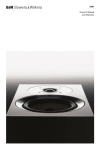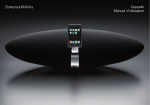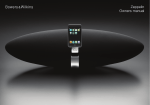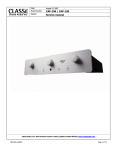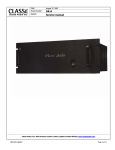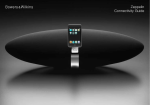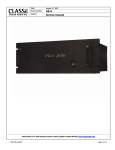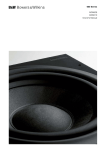Download Bowers & Wilkins CWM7 User's Manual
Transcript
English CWM7 Welcome to Bowers and Wilkins and the CWM7 Series Thank you for choosing Bowers & Wilkins. When John Bowers first established our company he did so in the belief that imaginative design, innovative engineering and advanced technology were keys that could unlock the enjoyment of audio in the home. His belief is one that we continue to share and it inspires every product we design. The CWM7 Series of in-wall speakers is designed to offer easy installation and very high quality audio reproduction for discrete custom install applications. This manual describes the installation of CWM7 Series speakers within conventional stud and sheetrock (joist and plasterboard) walls. It begins by listing the contents of the CWM7 series carton: www.bowers-wilkins.com 2 1. CWM7 Carton Contents 2. CWM7 Series Basics CWM7.3 CWM7.4 1 1 1 CWM7.3 1 • CWM7 Series speaker assembly (baffle, frame/back box, grille) • Reservoir box • Cut-out template • Paint mask • Port plug • Blanking Plate • L-shaped push-lock fastener removal tool • Allen key (CWM7.3 only) • Document pack containing Quick Start Guide and Warranty information Environmental Information All Bowers & Wilkins products are designed to comply with international directives on the Restriction of Hazardous Substances (RoHS) in electrical and electronic equipment and the disposal of Waste Electrical and Electronic Equipment (WEEE). These symbols indicate compliance and that the products must be appropriately recycled or processed in accordance with these directives. Consult your local waste disposal authority for guidance. CWM7 Series in-wall speakers comprise a baffle carrying the speaker drivers and crossover, an integrated back-box and front flange, and a magnetically secured grille. The back box is connected via external terminals to the speaker cables with the baffle connecting automatically as it is inserted in the back box. A reservoir box can be fitted within the wall either above or below the back box to enhance the speaker’s low frequency performance. The CWM7.3 incorporates a MF/HF baffle that can be rotated 90° to enable the speaker to be used in landscape orientation for centre channel applications. CWM7 Series speakers require wall aperture dimensions described in the following table: Model Aperture Height Aperture Width Reservoir Box Clearance CWM7.3 711mm (28 in) 251mm (9.9 in) 465mm (18.31 in) CWM7.4 390mm (15.4 in) 226mm (8.9 in) 465mm (18.31 in) CWM7.5 331mm (13 in) 187mm (7.4 in) 390mm (15.4 in) 3 3. Positioning CWM7 Series Speakers CWM7.5 All CWM7 Series speakers require a clear depth of 102mm (4.02 in) from the front of the ceiling surface. Note: The CWM7.3 can also be used in landscape orientation with aperture dimensions of 251mm (9.9 in) by 711mm (28 in) respectively height by width. No reservoir box is used with the CWM7.3 in landscape orientation. Note: The reservoir box clearance is the clear distance within the wall above or below the aperture required to accommodate the reservoir box. Before installing CWM7 Series speakers you should ensure that the wall locations chosen are free of obstructions such as pipe work, ducting or wiring that will interfere with the installation. In existing dry-wall construction, use a stud-finding tool to help you map the wall construction and a pipe detector to scan the proposed installation locations. Note: CWM7 Series in-wall speakers will most often be installed in existing walls, however, if they are to be installed in newly constructed walls a premount kit that aids appropriate wall construction is available. Contact your local Bowers and Wilkins retailer for more information. The appropriate position for CWM7 Series speakers within the listening environment will depend on their specific application: General Background Audio Applications: For applications where single CWM7 Series speakers are required to operate independently to provide background audio, they can be located substantially as installation convenience and architecture dictate. The only acoustic constraint to bear in mind is that corner locations will result in significantly emphasised low frequencies and should be avoided. Stereo Audio Applications: For applications where a pair of CWM7 Series speakers is to be used for conventional stereo reproduction, they should be located between 3m (10 ft) and 5m (16.5ft) apart and a similar distance in front of the listening area. Try to avoid corner locations for the speakers and to ensure that acoustic environment around each speaker is similar. Note: Different acoustic environments might be, for example, a bare wall and a heavily curtained window. Multi-channel Audio Applications For applications where multiple CWM7 Series speakers are to be used for multi-channel audio visual systems the left and right front speakers should be located either side of the screen approximately 0.5m (20 in) away. The centre channel speaker should be located either directly above or below the screen or, in the case of an acoustically transparent screen, directly behind. Surround channel CWM7 Series speakers should be located just behind and either side of the listening position. Try to avoid corner locations for any of the speakers and to ensure that acoustic environment around each front and surround speaker is similar. Note: Different acoustic environments might be, for example, a bare wall and a heavily curtained window. Note: The nature of the installation of in-wall speakers means that it is sometimes impractical to locate them in the acoustically ideal positions. In these cases they should be located as close as is practical to the ideal positions. Your local Bowers and Wilkins retailer will be able to offer advice if required. Note: CWM7 Series drive units create stray magnetic fields. We recommend that magnetically sensitive items such as CRT screens and magnetic cards for example, are kept at least 0.5m (20 in) from the speaker. LCD, OLED and plasma screens are not affected by magnetic fields. 4 4. Installing CWM7 Series Speakers To install a CWM7 Series speaker proceed as described in the following paragraphs: 4.1 Using the supplied cut-out template, mark a cut line on the wall. Check the cut line defines the correct dimensions. Cut along the line with an appropriate tool to create an aperture in the wall. Note: Ensure that there is enough free space internally adjacent to the aperture for the back box clamps to rotate fully outwards. 20mm (0.79 in) free space is required. Note: To reduce the possibility of the ceiling buzzing or rattling, adhesive mastic can be applied between the studs and sheetrock in the vicinity of the speaker aperture. 4.2 The reservoir box enhances the low frequency performance of CWM7 Series speakers. It connects to the top or bottom of the back box via a hinge and clamp that enables it to be fed into the wall cavity above or below the back box. CWM7 Series speakers are shipped set up for the reservoir box to be installed below the back box. If this is not practical, perhaps thanks to the encroachment of drywall frame noggin (horizontal brace), the reservoir box can be swapped for use above the back box. Note: An arrow symbol on the back box illustrates upward orientation. To swap the reservoir box location, the blanking plate screwed to the lower inside panel of the back box must be unscrewed and replaced to cover the hole in the upper inside panel. Ensure that the thumb screws securing the blanking plate are adequately tight. The diagram above illustrates the removal and replacement of the blanking plate and attachment of the reservoir box. 4.3 If speaker cable is already present in the wall space, pull the cable through the aperture. If speaker cables are not already installed this should be done at this stage. It is likely that you will need to gain access through the floor above to route the cables down into the wall cavity. Leave enough spare cable through the aperture to ease connection to the speaker back box, but not so much that it is likely to buzz or rattle when pushed back up into the cavity. Approximately 1.0m is appropriate. Note: Always use high quality, low resistance speaker cable. Low resistance is especially important if the length of cable from amplifier to speaker exceeds 5m. Your local Bowers and Wilkins retailer will be able to offer advice on speaker cable selection if required. We recommend that the reservoir box is always used if possible, however with a CWM7.3 speaker installed in landscape orientation, use of the reservoir box is not possible. If no reservoir box is used a blanking plate must be fitted to both back box holes. 5 4.4 Now connect the speaker cable to the spring terminals on the side back box, first looping the cable around the strain relief bar. The diagram above illustrates cable connection. Ensure that the speaker connection polarity is correct: the cable connected to the positive terminal on the amplifier should be connected to the red spring terminal on the back box. Similarly, the cable connected to the negative terminal on the amplifier should be connected to the black spring terminal on the back box. Note: If an amplifier is already connected to the cable it should be switched off while connections are being made to the back box. 4.5 With the back box connected to the cable and its reservoir box attached it may be inserted into the wall aperture and cavity. Correct back box orientation must be established at this stage: the red arrow on the back box flange should be pointing upwards. Ensure that the clamps are retracted so that they will pass through the aperture then feed the reservoir box into the cavity below (or above) the aperture followed by the back box itself into the aperture. Take care that the cable is not trapped. When the reservoir box and back box are adequately seated in place the clamps can be tightened. The diagram above illustrates insertion of the reservoir box and back box. Finally tighten the two thumbscrews to secure and seal the reservoir box. Note: If no reservoir box is fitted the back box is simply inserted straight into the aperture. 6 4.6 If the back box flange is to be painted it should be done at this stage. Any conventional, domestic paint may be applied by brushing, rolling or spraying. Use the supplied paint mask to avoid getting paint in the back box cavity. Painting without using the paint mask risks contamination of the internal connection terminals or the grille attachment magnets. The diagram above illustrates painting using the paint mask. Note: If the grille is to be sprayed this should be done “off-line” before it is fitted. 4.7 The baffle can now be inserted into the back box. The baffle insertion and attachment technique is slightly different in the case of the CWM7.3 and CWM7.4/5. In both cases however you should first ensure that the connector on the baffle is oriented correctly with the connector inside the back box. CWM7.3 Baffle Insertion If the CWM7.3 is to be used in landscape orientation the MF/HF baffle must be removed and rotated 90° so the tweeter is uppermost in the installed speaker. If necessary, this should be done before the baffle is inserted in the back box. With the MF/HF baffle in the correct orientation the baffle assembly can be lifted and inserted in the back box till it is just sub-flush of the back-box flange. Take care to ensure that the electrical connector lines up. The baffle is held in the back box by eight screws. Tighten the screws to a torque of 1.5Nm. The baffle will then be secured in the back box. To rotate the MF/HF baffle first remove the four screws holding it in place. Now, with your hand gently over the midrange driver, lean the whole baffle assembly forward slightly so that the MF/HF baffle begins to fall out. Do not let it fall completely but return the baffle to the upright position while holding the MF/HF baffle out of its rebate. Finally withdraw the MF/HF baffle completely, turn it 90°, reseat it in the rebate and replace the four screws. Tighten the screws to a torque of 1.5Nm. The diagram above illustrates removal and rotation of the MF/HF baffle. 7 CWM7.4 and CWM7.5 Baffle Insertion The CWM7.4/5 baffle assembly is held in the back box by a combination of hinge features and push-lock fasteners. To secure the baffle assembly in the back box, lift the baffle up to the back box and engage the two pegs on its lower edge at an angle within the holes inside the back box flange. Now simply rotate the baffle inwards so that the electrical connector engages and the baffle sits just sub-flush of the back-box flange. The baffle is held in the back box by two pushlock fasteners. Push-lock fasteners are secured by pushing the head inwards – either with a thumb or a screwdriver. As they secure, the fasteners will click three times. The baffle will then be secure in the back box. The diagram above illustrates inserting the baffle and securing the push-lock fasteners. Note: Push-lock fasteners are unsecured by turning anticlockwise with a screwdriver. The supplied L-shaped tool can now be used to hook and lift behind the fastener head. 8 4.8 A port plug accessory is included with CWM7 Series speakers. The plug can be used if desired to reduce bass output by obstructing the speaker’s reflex port. Simply push the plug into the reflex port. The diagram above illustrates insertion of the port plug. 4.9 The grille can now be fitted to the baffle. It is held in place magnetically so simply needs to be aligned with the groove in the back box flange where it will click into place. The diagram above illustrates fitting the grille. The CWM7 Series speaker is now installed and ready for use. 9 Issue1 B&W Group Ltd Dale Road Worthing West Sussex BN11 2BH England T +44 (0) 1903 221 800 F +44 (0) 1903 221 801 [email protected] www.bowers-wilkins.com B&W Group (UK Sales) T +44 (0) 1903 221 500 E [email protected] B&W Group North America T +1 978 664 2870 E [email protected] B&W Group Asia Ltd T +852 3 472 9300 E [email protected] Copyright © B&W Group Ltd. E&OE










